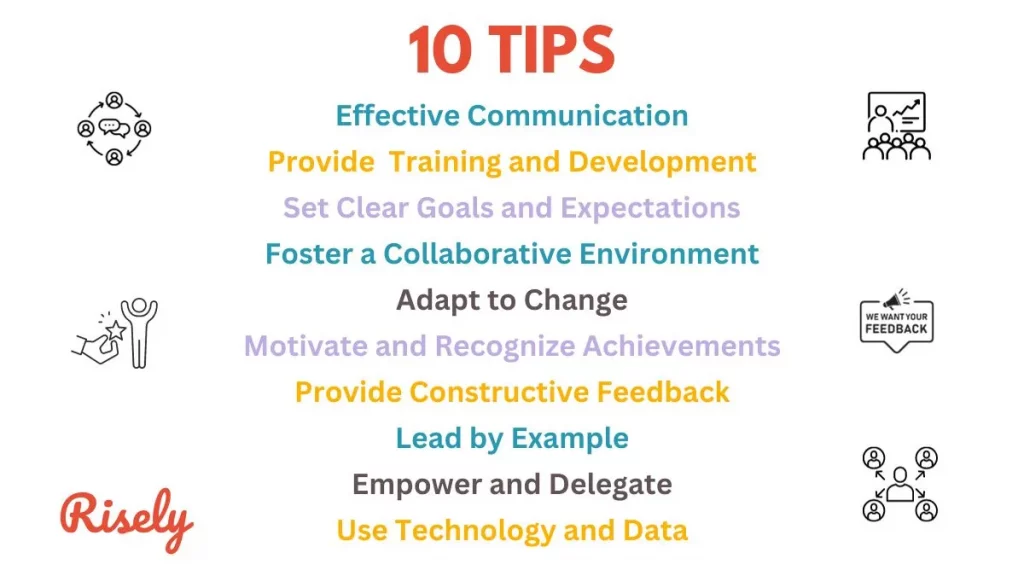Be a Top Lead Sales Manager: 10 Tips and Examples
Being a Lead Sales Manager is not an easy task. It requires unique skills, including excellent communication, leadership qualities, and the ability to motivate a team. This comprehensive guide will walk you through everything you need to know about becoming a successful Lead Sales Manager. From understanding who is a lead sales manager to differentiating between a sales lead and a sales manager, we have covered everything. We will also provide you with our top 10 tips on how to effectively lead your sales team with examples of how to implement them. Additionally, we will discuss how to manage a sales meeting effectively by planning. By the end of this guide, you will be equipped with all the necessary knowledge to become an expert Lead Sales Manager and achieve maximum success in your role.Who is a Lead Sales Manager?
Lead sales managers are responsible for guiding and overseeing a team of sales professionals. They provide strategic direction and support to drive revenue growth and achieve sales targets. Collaborating with other departments they ensure alignment to maximize sales opportunities. As a lead sales manager, your key responsibilities include setting sales targets and motivating your sales team to achieve them. You also provide coaching and training to improve their skills and performance. Analyzing sales data allows you to identify trends and make data-driven decisions. Building strong relationships with clients and key stakeholders is essential. Additionally, continuously monitoring and optimizing the sales process drives efficiency and effectiveness. You can effectively lead your sales team to success by fulfilling these responsibilities.Other Interesting Reads
Sales Lead vs Sales Manager
Sales Lead and Sales Manager are essential roles within a sales organization but have distinct responsibilities and functions. Here are some key similarities and differences between these two roles:Similarities:
- Sales Focus: Both roles primarily focus on driving sales and revenue for the organization. They work towards achieving sales targets and goals.
- Customer Interaction: Sales Leads and Sales Managers interact with customers and clients. They may engage in sales meetings, negotiations, and relationship-building with potential and existing customers.
- Team Collaboration: In many cases, both Sales Leads and Managers work closely with sales teams and collaborate on sales strategies and tactics.
Differences:
- Position and Hierarchy:
- Sales Lead: Sales Leads are typically individual contributors or team leaders who oversee a smaller group of salespeople. They report to Sales Managers.
- Sales Manager: Sales Managers are typically in a higher managerial position and are responsible for managing multiple sales teams or a larger group of salespeople. They often report to higher-level executives or directors.
- Responsibilities:
- Sales Lead: Sales Leads are often responsible for directly generating sales, prospecting, closing deals, and meeting individual or team quotas. They may also provide coaching and mentoring to junior sales team members.
- Sales Manager: Sales Managers have a broader set of responsibilities, including setting sales targets, creating and implementing sales strategies, performance management, team development, and reporting to higher management.
- Leadership and Decision-Making:
- Sales Lead: While Sales Leads may provide guidance and leadership within their team, their decision-making authority is typically limited compared to Sales Managers.
- Sales Manager: Sales Managers have greater decision-making authority and are responsible for making strategic decisions that affect the entire sales department.
- Coaching and Development:
- Sales Lead: Sales Leads may coach and guide individual team members to improve their sales skills.
- Sales Manager: Sales Managers play a more significant role in coaching, training, and developing their entire sales team, focusing on long-term team growth and success.
How to Lead a Sales Team: Top 10 Tips
Leading sales teams can be a challenging but rewarding role. Here are the top 10 tips for being an effective lead sales manager:- Lead by Example:
- Demonstrating a strong work ethic and effective sales techniques sets a positive example for your team. Your actions should reflect the behavior you expect from your team members.
- Example: As a Sales Manager, you consistently call important leads, close deals, and engage in follow-up activities to demonstrate effective sales techniques to your team.
- Set Clear Goals and Expectations:
- Define clear and achievable sales targets, both individually and as a team. Ensure your team knows what’s expected of them and how their performance will be measured.
- Example: You set weekly and monthly sales targets for each team member and regularly review their progress. For instance, you might say, “This month, we aim for a 20% increase in revenue from last month.”
- Provide Ongoing Training and Development:
- Invest in the continuous learning and development of your team’s skills to excel as a manager. Offer training sessions, workshops, and resources to help them improve their product knowledge and sales techniques.
- Example: You schedule weekly training sessions on product updates and market trends to ensure your team stays knowledgeable and competitive.
- Effective Communication:
- Maintain open and transparent communication with your team. Regularly share updates, feedback, and essential information. Encourage your team to ask questions and provide feedback.
- Example: You hold a daily morning meeting to share updates on leads, deals in progress, and any changes in company strategy, keeping your team informed and aligned.
- Motivate and Recognize Achievements:
- Recognize and celebrate the successes of your team members. Offer incentives, rewards, or recognition for hitting targets and milestones. Positive reinforcement can boost morale and motivation.
- Example: When a team member achieves their monthly quota, you publicly acknowledge their achievement, perhaps with a “Salesperson of the Month” award or a bonus.
- Empower and Delegate:
- Give your team members autonomy and responsibility. Trust them to make decisions and handle their accounts or leads. Empowerment can increase job satisfaction and performance.
- Example: You delegate specific territories or key accounts to individual team members, giving them autonomy to manage those relationships and make decisions.
- Foster a Collaborative Environment:
- Encourage teamwork and collaboration among your sales team members. Sharing insights and best practices can help everyone improve and learn from one another.
- Example: You encourage team members to hold regular brainstorming sessions to share successful sales strategies and learn from one another’s experiences.
- Provide Constructive Feedback:
- Offer constructive feedback to help your team members improve. Focus on their strengths and areas for growth. Support them in developing a plan to address areas needing improvement.
- Example: During one-on-one meetings, you provide feedback on a team member’s recent client presentation, highlighting what they did well and suggesting areas for improvement.
- Adapt to Change:
- The sales environment is dynamic. Be prepared to adapt to changes in the market, customer preferences, and product offerings. Encourage your team to be flexible and open to change.
- Example: When there’s a shift in market demand, you guide your team in modifying their approach and product positioning to meet changing customer needs.
- Use Technology and Data:
- Leverage technology and data analytics to help your team work smarter. Implement CRM systems, sales analytics, and other tools to track performance and identify areas for improvement.
- Example: You regularly review CRM data to identify trends and opportunities, helping your team prioritize leads and allocate resources effectively.

Managing a Sales Meeting Effectively
Effective sales meetings are crucial for keeping your sales team informed, motivated, and on track to achieve their goals. Here are five ways to manage a sales meeting effectively:- Set Clear Objectives: Before the meeting, define clear objectives and goals. What do you want to achieve during this meeting? Whether reviewing performance, sharing updates, or addressing challenges, having a clear purpose will keep the discussion focused.
- Create an Agenda: Develop a structured agenda and distribute it to participants in advance. Include time allocations for each topic, and prioritize the most important items. This ensures the meeting stays on track and doesn’t get derailed by unrelated discussions.
- Engage and Encourage Participation: Encourage active participation from all team members. Create a culture where team members feel comfortable sharing their insights, asking questions, and offering suggestions. This can lead to valuable discussions and the sharing of best practices.
- Use Technology Wisely: Leverage technology to enhance the meeting’s effectiveness. Use visual aids like slides or charts to illustrate key points. Additionally, consider using video conferencing or collaboration tools for remote team members. However, be mindful of overusing technology, which can lead to disengagement.
- Follow-Up and Action Items: After the meeting, send out meeting minutes or a summary of what was discussed, including action items and responsibilities. This ensures everyone is on the same page regarding next steps and expectations. Follow up on action items at the next meeting to track progress.
Conclusion
In conclusion, being a successful lead sales manager requires strong leadership skills, effective communication, and a deep understanding of the sales process. Following the tips outlined in this guide, you can create a cohesive team, set achievable goals, and implement strategies that drive results. Remember to prioritize clear communication, provide regular training sessions, and foster a healthy work-life balance for your team. With these practices in place, you’ll be well on your way to success as a lead sales manager. Keep empowering your team and leading them towards greater heights of success.Take your team to great heights with strong feedback skills.
Master the art of constructive feedback by reviewing your skills with a free assessment now.
Other Related Blogs
How To Motivate Remote Employees In Your Team?
How To Motivate Remote Employees In Your Team? Teams worldwide are adapting to new working styles, and a remote setup is no longer uncharted territory for many organizations. In fact,…
How To Create Purpose At Work For Your Employees?
How To Create Purpose At Work For Your Employees? Why is purpose at work important in the modern workplace? Picture this: You stroll into the office, a spring in your…
Becoming an Effective Employee Relations Manager: 5 Skills You Need
Becoming an Effective Employee Relations Manager: 5 Skills You Need As an Employee Relations Manager, you are crucial in ensuring that employee needs are met and the organization operates smoothly.…
5 Ways to Identify and Develop High-performer Employees in Your Team
5 Ways to Identify and Develop High-performer Employees in Your Team As a manager, one of the most important things you can do is identify and develop high-performing employees in…







